MRRL Hall of Fame
SIXTH GENERATION
- Details
- Category: Inductees
- Created: Friday, 07 October 2011 08:38
- Written by Gary Johnson
Niles, Michigan is a small town situated on the St. Joseph River, located in the southwest corner of the state of Michigan. Just six square miles in size, the city is a few miles north of the Indiana border and the large city of South Bend. The ties between the two states are so great in this area that the name “Michiana” is commonly used by the locals to describe it.
Musically, the most important figure in Niles is Tommy James. He grew up in the city as Tom Jackson, attending Niles High School and forming his first rock band, The Tornadoes, there in 1962. In 1964, the band had evolved into The Shondells and recorded their classic single, “Hanky Panky”, at the local WNIL-AM studio, and released it on the tiny Snap record label.
“Hanky Panky” was a big local hit for Tom Jackson and The Shondells in 1964. He and the other members of the band became one of the main influences to a number of area youngsters who would stand next to the stage at the Elks Club, the American Legion Hall, and the Y.M.C.A. in Niles, carefully watching how The Shondells set up their drums, amps, and microphones, and how they stood and played their instruments on stage. Two years later, six of these Michiana teens would come together to form the Sixth Generation, one of southwest Michigan’s most popular bands. 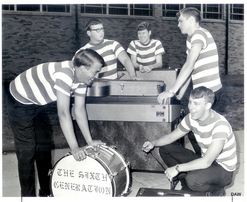 The Sixth Generation
The Sixth Generation
Ron Hamrick started playing music at the age of eight. He was a fan of Elvis Presley and Ritchie Valens, and was also influenced by an aunt who was a guitar player in a rock and roll band. Ron’s grandmother had a piano in her home and he fell in love with it soon after he pressed his first keys. He started taking lessons after his parents bought him a Hammond organ. Watching the performances of The Beatles in 1964 on the Ed Sullivan Show prompted him to start a rock and roll band in the eighth grade with Fred Bachman called The Royal Coachmen.
Hamrick sat next to Tom Jackson in choir when he was a senior and Ron was a freshman at Niles High School. Hamrick was also acquainted with three of the other original Shondells: guitarist Larry Coverdale, drummer Jim Payne, and pianist Craig Villeneuve. The Shondells often practiced in Coverdale’s garage, and Ron would walk over and watch them; sometimes he even got to sit in with the band.
Dave Walenga and Paul Davies were also inspired by The Beatles and The Shondells to start their first band. The Vampires came into existence in the summer of 1965 when two friends, Larry Townsend and Bob Lowery, joined up with Walenga and Davies. They played their first dance on July 4th at the Y.M.C.A. in Niles. Their eight-song repertoire included Roy Orbison’s “Oh, Pretty Woman”, Roger Miller’s “King Of The Road”, and the Beatles’ version of “Kansas City”.
The Vampires and The Royal Coachmen didn’t play any of the same dances but both bands knew each other from school. Other than being active in the school’s music program, none of them did much in the way of extra-curricular activities. They didn’t play sports; their rock and roll bands were the big thing in their lives. There were lots of places for both groups to play – high school dances, small clubs, and at the teen center in nearby Buchanan where they first met John Dale.
John grew up on a farm in Buchanan, a small community located 5 miles west of Niles. No one in his family played music. He was inspired to start taking guitar lessons after watching Ricky Nelson and James Burton playing on The Adventures of Ozzie and Harriet and then seeing The Beatles on Ed Sullivan. John’s first experience playing in public was in a folk group called the Brothers Not. He then joined a Buchanan band called The Outcasts before meeting Walenga and Davies at the teen center and joining them in The Vampires.
Hamrick (keyboards), Bachman (lead vocals), Walenga (drums), Davies (bass), and Dale (guitar) joined forces when both of their bands broke up in 1966. They played under several names, including The Boys Next Door, before adding sax player Dale Chadderdon to the line-up and coming up with ‘Sixth Generation’ as their new moniker. It was perfect; there were six band members, and being primarily a cover band, they were playing the music of their generation.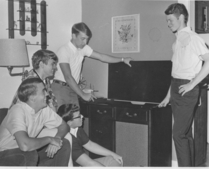
Although they are best described as a “garage band”, they rehearsed mostly indoors in Fred Bachman’s basement, John Dale’s family room, and at Ron Hamrick’s house. To Dave Walenga, a garage band means “getting together for the love of the music,” and rock and roll has always been what it’s all about for the members of the Sixth Generation. “It was so simple then,” Walenga said, recalling that they were motivated less by fame and fortune than by finding the “friends you wanted to make music with.”
They also consider themselves lucky to have grown up in an era when bands were able to form and thrive in a host of local and regional venues. The Sixth Generation quickly became a top draw in southwest Michigan and northern Indiana, while riding the giant garage band wave formed in the wake of the British Invasion; and also by the surprising national acclaim achieved by Tommy James and The Shondells when “Hanky Panky” came out of nowhere to reach # 1 on the Billboard Hot 100 in the summer of 1966.
This was the era of the teen dance clubs and the Sixth Generation played a large number of them including the White Rabbit in Niles, the Shadowland Ballroom in in St. Joseph, the Blossomland Lodge in Benton Harbor, The Place in Grand Rapids, the Fifth Dimension in Ann Arbor, and a former funeral parlor in Holland, Michigan, that was turned into the Edgar Allan Poe Club.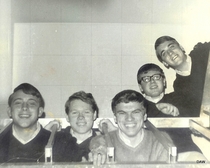
Although Niles was a typical small town in Michigan, it was just six miles away from the University of Notre Dame in South Bend, Indiana; a big city with a number of large clubs like the Top Deck that would bring in name acts like The Cryan’ Shames and Doug Clark and The Hot Nuts. The Sixth Generation played there as well, and all of them remember having to hump their equipment up the stairs to the club’s stage.
The band was also a popular attraction on college campuses, playing dates at Michigan State, Ferris State, and Grand Valley State; but far more important was their steady Saturday night gig as the house band at the Skyliner in Dowagiac, Michigan.
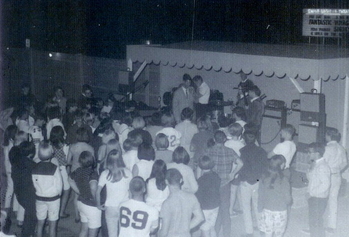 Sixth Generation on stage
Sixth Generation on stage
Located at Five-Mile Corner north of Dowagiac, the Skyliner was considered to be the most popular dance venue in southwest Michigan, and it frequently hosted shows featuring DJs such as Dex Card and Bernie Allen from Chicago’s powerful AM stations WLS and WCFL, along with nationally known recording acts. This connection led to the Sixth Generation being hired to open for artists the caliber of The Kingsmen, The Buckinghams, The Box Tops, The Ides Of March, Mitch Ryder and The Detroit Wheels, and The Electric Prunes.
Marie Needham, co-owner of the Skyliner, was quick to realize the Sixth Generation’s potential and became the band’s manager. Needham was a calming influence on the young group, and she was the first adult besides their parents to take an interest in them. The Skyliner was to the Sixth Generation what The Cavern was to The Beatles. The steady gig gave them the opportunity to play constantly and build a following.
Their manager was also instrumental in getting the band to record a single. Ron Hamrick and Fred Bachman had written a catchy song called “This Is the Time”, and Needham took the band to the Sound Studios in Chicago on May 18, 1967, to record it at along with a song originally done by The Turtles called “Glitter And Gold”. Carl Bonafede, the manager of The Buckinghams, was in the studio during the session that was engineered by Stu Black.
Unfortunately, Marie Needham’s inexperience in the recording industry became painfully apparent when neither she nor the band knew how to obtain a release for “Glitter And Gold” in order to get the song published. As a result, “This Is The Time” was released as both the A and the B-side of the single issued on the tiny GMA label. Despite the mess-up, “This Is the Time” went into heavy rotation on WLS and became a regional hit in southwest Michigan and in other markets in the Midwest including the Windy City.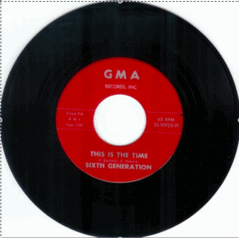 "This Is The Time" 45
"This Is The Time" 45
“This Is the Time” hit the # 1 spot in Niles and also in Pittsburgh, the city that had first broke “Hanky Panky”; but Marie Needham didn’t know how to pursue a major label in order to get national distribution for the record, and it soon faded into obscurity.
Like Tommy Jackson (James) before him, Dave Walenga had an afterschool job working at Spin-It Records, the only record shop in Niles. Dave’s job was to mop the floor and clean the windows in the tiny store owned and operated by Edith “Dickie” Frucci, and located just off the lobby of the Four Flags Hotel in the downtown business district. Once he was done, Dave could sample all the newest releases, including their flipsides. Another attraction at Spin-It was to pick up a copy of the latest WLS Silver Dollar Survey listing the station’s top hits of the week.
The Chicago influence is very strong in southwest Michigan. The area has been a popular vacation spot for Chicagoans for many decades, and in the 60’s, WLS and WCFL were more important to area teens than any of the Detroit rock and roll stations. Walenga grew up in a household where his dad supported the Chicago White Sox and Bears rather than the Detroit Tigers and Lions, and Dave would go to bed with his AM radio tucked under his pillow to listen to the jocks on the big Chicago stations spin the latest rock and roll hits, rather than those from the Motor City.
By the time that the band members graduated from high school in 1967, the line-up had begun to change. Dale Chadderdon had left the band earlier in the year, and Ron Hamrick and Fred Bachman departed in the fall to attend college. 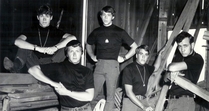
Niles native Fred Hulce joined on organ and vocals, and the Sixth Generation became a quartet at the dawn of 1968. John Dale was enrolled at Grand Valley State, both Paul Davies and Dave Walenga were taking classes at Ferris State, and Fred Hulce was attending Michigan State. Hulce, who had his organ with him at school, claims that the Hammond was a source of date bait for Spartan co-eds whenever he unleashed his humorous pick-up line; “I have the biggest organ on campus.”
Every weekend for the next two years, the band got together to play local high schools, colleges and dances primarily in southwest Michigan, since Marie Needham had trouble booking the band outside her sphere of influence. Fittingly, their final performance came close to home at the American Legion Hall in Buchanan in December of 1970.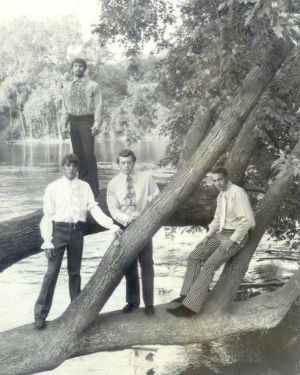
Ron Hamrick had one final brush with fame in the early 70’s when he toured as a keyboard player with the original line-up of the Eagles: Glenn Frey, Don Henley, Bernie Leadon, and Randy Meisner. The Eagles were on the road promoting their first album and their Top 40 hits: “Take It Easy”, “Witchy Woman”, and “Peaceful Easy Feeling”. Ron had a great time sampling the rock star life and got to play in some of the most famous venues in the United States, including Madison Square Garden.
After the break-up, lifelong friends Paul Davies and Dave Walenga stayed in close contact over the years, but saw the others infrequently. The band members pursued a variety of careers that included teaching, sales, construction, law, and even heading up an international company. Walenga noted in a recent interview that while all the guys went on to other things their enduring love of music still bound them together.
Everyone who played in the band is still alive, allthough Fred Bachman had a major health issue when he lost his voice completely due to a medical condition called dysphonia while teaching in Alaska. Fred had a very serious form of the vocal disorder and his doctors thought that he would never be able to sing again. He began his remarkable recovery by first reading about his condition on the internet. Fred learned that humming could stimulate the vocal chords; and they gradually started getting stronger, allowing him first to speak and then slowly begin to sing again.
This became doubly important when, after a period of 40 years, the Sixth Generation decided to reunite in October of 2010. Walenga says, “After 40 years, we each had hidden desires to get the band back together”. They were also encouraged by their old fans, not only in Michiana, but all around the United States.
Paul Davies daughter, Amanda Lingerfelt, first suggested that they should get back together in the summer of 2010. She started a Facebook page for the band and people quickly began contacting them. “She thought it was pretty neat that we had a band back then,” Davies said. Getting back together was more difficult than it sounded, however, since three of the members now live on the East Coast and the others in different parts of Michigan.
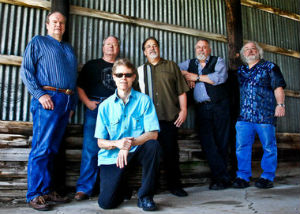 Sixth Generation reunion: Ron Hamrick, John Dale, Fred Bachman, Dave Walenga, Fred Hulce, Paul Davies
Sixth Generation reunion: Ron Hamrick, John Dale, Fred Bachman, Dave Walenga, Fred Hulce, Paul Davies
All have found the time and effort to put the Sixth Generation back on stage has been worth it. According to Walenga, the band members have enjoyed playing music together again. “We’re having a ball and working really hard on it,” he said. They now also have their own Sixth Generation website to further promote the band.
Four decades after its heyday, the Sixth Generation has returned to live performances. The band is careful to protect Fred Bachman’s voice as much as possible. He doesn’t do any interviews on the days of a show to preserve his vocal chords. Although Bachman is still an animated frontman for the band, Dave Walenga, Paul Davies, and Fred Hulce sing lead on quite a few songs in concert so that he doesn’t strain his voice.
John Dale also feels fortunate to be able to take the stage again. He had to recover from a crushed nerve in his left hand 12 years ago that threatened his ability to play guitar, and he has also made a remarkable recovery.
Bassist Paul Davies is probably the most laid-back member of the Sixth Generation. Called “General” by his band mates, he is the only one who still resides in Niles. I originally thought his nickname might have had something to do with the fact that, with his longish grey hair and beard, he looked something like the famous Civil War general, Robert E. Lee. I found out the amusing story behind the nickname while interviewing the band, however.
During the 60’s, each young man who reached the age of 18 faced the military draft. Part of the process was taking a bus trip to Detroit for the pre-induction physical. While on the long ride, Davies felt compelled to stand up on the bus and loudly announce; “When I get in the Army, they’re going to make me a general”. To this, the bus driver looked back at him and yelled; “Yeah, you’re going to be a general, a general f**k-off!” Paul has been called “General” ever since.
It was fitting that Davies, Walenga, Hamrick, Bachman, Dale, and Hulce celebrated their reunion show with family, friends, and fans at the American Legion Hall in Buchanan on July 16, 2011. It was the same venue where they played what they thought was their final show a little over 40 years before. The dance was the first leg of what they were calling the Full Circle Tour. The next day they played an outdoor concert in Niles.
The band members said they consider themselves lucky not only to have grown up in the era that they did, but also to be able to come back together after so many years and find that the magic was still there. The Sixth Generation was cover band in the 60’s, and they took great pride in being able to duplicate the big hits of the day. Today their set is composed of “This Is the Time” along with a bevy of 60’s hits by such stalwarts as the Spencer Davis Group, Del Shannon, The Kinks, The Rascals, The Beatles, The Kingsmen, and The Shondells’ “Hanky Panky”, the unofficial rock and roll anthem of Niles.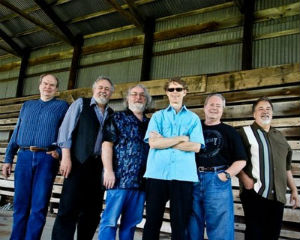
Although they had no intention back in the day of trying to be overly creative, the reunited Sixth Generation is interested writing new material; and they are working some of their new songs into their set. Looking back, the band members feel that they didn’t completely appreciate what they did back in the 60’s, and that is the subject matter of a new composition by Hamrick and Bachman called “That Was The Time”. An original blues tune by Davies and Walenga called “I Can’t Believe I Made It” takes a humorous look at the days when they were growing up in Niles and how things have changed.
The Sixth Generation’s Full Circle Tour scheduled dates on the East Coast during the fall of 2011. Happy to be playing together again, they feel sorry that kids today don’t have the same chance to form a band and play teen dances or stand by the stage and watch bands play like they did in the 60’s. A future Sixth Generation project might involve a ‘School of Rock’ undertaking that would give kids a shot at playing rock and roll on stage. It would provide an excellent opportunity for the band to give something back to the music that has given so much to them.
The Sixth Generation was voted into Michigan Rock and Roll Legends in 2011. "This Is The Time" was voted a Legendary Michigan Song in 2013.
Although the band was reduced to five with the retirement of John Dale, their reunion has proceeded full-speed ahead. The Sixth Generation produced a new album in 2012 containing a song called "That Was The Time", written as a follow-up to their 1967 single; and they toured England in 2013. The following year, they played before large crowds at both the National Cherry Blossom Festival and Rolling Thunder in Washington D.C.
MRRL Hall of Fame: https://www.michiganrockandrolllegends.com/mrrl-hall-of-fame
Watch a video fhttps://www.michiganrockandrolllegends.com/mrrl-hall-of-fameor a reunion performance of The Sixth Generation's 1967 hit single "This Is The Time" https://www.youtube.com/watch?v=chOYJ1a0yDw
Watch a video for "That Was The Time", one of the Sixth Generation's new compostions and a sequel to their 1967 hit https://www.youtube.com/watch?v=7_6jVL8_obw
